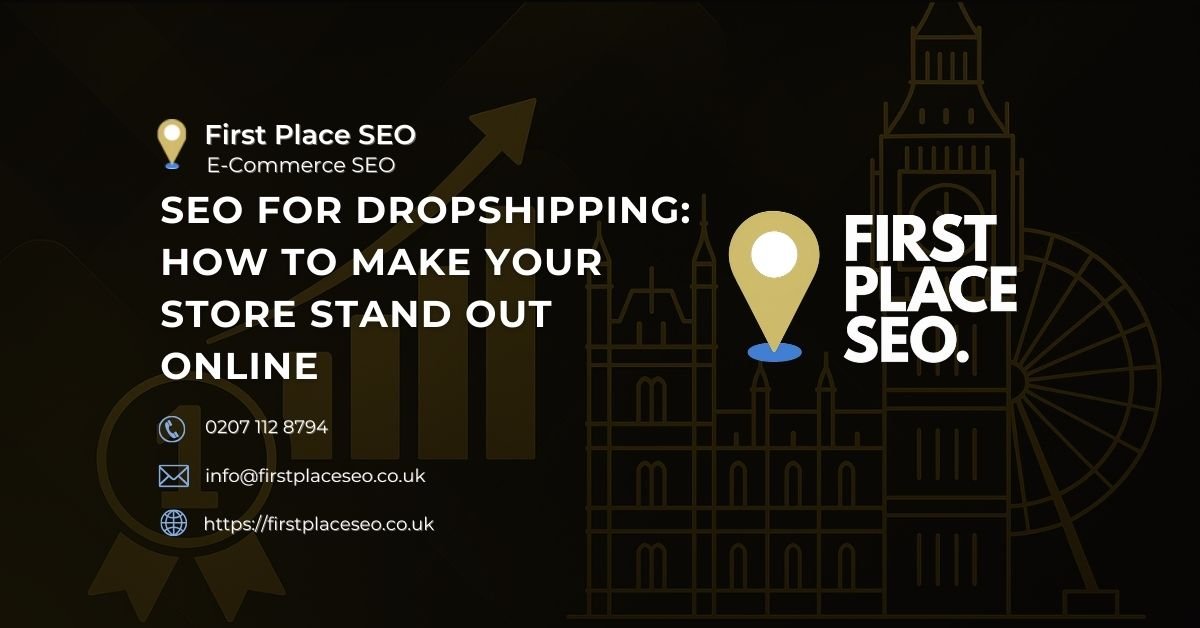The best proven SEO practices for Ecommerce sites are to:
- Speed up your website.
- Leverage long-tail keywords.
- Streamlined website structure.
- Manage redirection & 404 Errors.
- Homepage optimisation
- Ensure mobile optimisation.
- Update content regularly.
- Prioritise link building.
- Product videos.
- Use professional SEO agency services.
Search Engine Optimisation (SEO) is the most cost effective strategy to increase sales for eCommerce sites. This article outlines these ten proven SEO practices designed to enhance your online store’s search rankings and sales performance.
1. Speed Up Your Website
Customers expect quick access to product information and seamless shopping experiences. Slow website speeds not only frustrate users but also negatively impact your site’s search engine rankings. Here are some actionable steps to improve your site’s loading time:
- Optimise Images: Ensure all product images are compressed without compromising quality. Tools like Adobe Photoshop or free online services can reduce file sizes significantly. One I can recommend is TinyPNG
- Use a Content Delivery Network (CDN): CDNs store copies of your site’s content on servers around the world, allowing for faster content delivery to users no matter their location. Litespeed Cache is a good one here.
- Minimise HTTP Requests: Reduce the number of elements (scripts, images, CSS files) that need to load on each page.
- Choose Efficient Hosting: Not all hosting services are created equal. Select a provider known for speed and reliability, ideally one that offers eCommerce-specific hosting solutions.
By implementing these strategies, you can significantly enhance your website’s user experience and improve its SEO performance.
2. Leverage Long-Tail Keywords
Long-tail keywords, which are more specific and often longer than generic keywords, can dramatically improve your site’s traffic and visibility. They cater to the specific search queries of users, increasing the likelihood of attracting highly targeted visitors to your site. Here’s how to incorporate them:
- Conduct Thorough Research: Use tools like SEMrush or the Google Keyword Planner to identify long-tail keywords relevant to your products and industry.
- Incorporate in Product Descriptions: Seamlessly integrate these keywords into your product titles and descriptions, making them more discoverable.
- Create Content Around These Keywords: Beyond product pages, use long-tail keywords to inspire blog posts or articles that address specific queries related to your products.
By focusing on long-tail keywords, you’re not just aiming for higher traffic; you’re attracting visitors who are closer to making a purchase decision.
3. Streamline Website Structure
A well-organised website structure is crucial for both user experience and SEO. A logical hierarchy makes it easier for customers to navigate your site and for search engines to crawl and index your content. To streamline your website structure:
- Simplify Navigation: Limit the number of menu items and ensure every page is accessible within a few clicks from the homepage.
- Use Clear Category Labels: Organise products into clear, intuitive categories and subcategories. Avoid jargon that might confuse shoppers.
- Implement Breadcrumb Navigation: Breadcrumbs help users understand their location within your site hierarchy, making navigation straightforward.
An intuitive site structure not only enhances user satisfaction but also improves your site’s search engine performance by facilitating easier content indexing.
4. Efficiently Manage Redirection and 404 Errors
Managing redirections and handling 404 errors effectively ensures that potential customers don’t leave your site out of frustration. Here’s how to manage these issues:
- Regularly Check for Broken Links: Use tools like Screaming Frog SEO Spider to identify and fix broken links on your site.
- Use 301 Redirects Wisely: For discontinued products or moved pages, implement 301 redirects to similar products or categories to keep users on your site.
- Design a Helpful 404 Page: Customize your 404 page to include a search function, product categories, or a site map to help users find what they’re looking for.
Addressing these areas reduces customer frustration and helps maintain your site’s SEO integrity by ensuring link equity is preserved.
5. Homepage Optimisation for Quick Wins
Your homepage serves as the gateway to your eCommerce site, making its optimization crucial for capturing visitor interest. To make your homepage work harder for you:
- Highlight Key Products: Showcase best-selling, new arrivals, or on-sale products prominently.
- Ensure Clear Call-to-Actions (CTAs): Direct visitors towards taking desired actions, whether it’s exploring a product range or signing up for your newsletter.
- Optimise for Speed and Mobile: Given the homepage’s pivotal role, ensure it loads quickly and is fully responsive on mobile devices.
A well-optimised homepage not only draws visitors in but also sets the tone for their entire browsing and shopping experience on your site.

6. Ensure Mobile Optimisation
With a significant portion of online shopping occurring on mobile devices, having a mobile-optimized site is critical. A mobile-friendly website not only provides a better shopping experience for users but also ranks higher in search engine results. To optimise for mobile:
- Responsive Design: Ensure your website’s design adapts seamlessly to different screen sizes and resolutions.
- Fast Loading Times: Mobile users expect quick loading times. Compress images and use mobile-specific speed enhancements.
- Easy Navigation: Simplify navigation for touch screens with larger buttons and streamlined menus to improve usability.
Mobile optimization is not just about aesthetics; it’s about creating an effortless experience that encourages sales and boosts your site’s visibility.
7. Regularly Update Content
Search engines favor websites with fresh, relevant content, viewing them as more valuable to users. Regular content updates signal to search engines that your site is active, improving your rankings. Here’s how to keep your content fresh:
- Maintain a Blog: Share insights, product news, and tips related to your industry to engage customers and drive traffic.
- Update Product Descriptions: Regularly revisiting and refining product descriptions keeps your content relevant and SEO-friendly.
- Encourage User Reviews: User-generated content, like reviews, not only enriches your product pages but also provides fresh content that search engines value.
Consistently updating your content fosters a dynamic online presence, attracting both new and returning customers.
8. Prioritise High-Quality Link Building
Backlinks from reputable sites are a testament to the credibility and authority of your eCommerce site. They significantly impact your site’s search engine ranking. To build high-quality links:
- Guest Blogging: Contribute valuable content to well-regarded blogs in your industry to gain backlinks.
- Supplier and Manufacturer Links: Ask suppliers or manufacturers you work with to include a link to your site on theirs.
- Create Shareable Content: High-quality, informative content is more likely to be shared by others, naturally generating backlinks.
Effective link building enhances your site’s authority, driving traffic and improving search engine rankings.
9. Incorporate Product Videos
Product videos offer a dynamic way to showcase your items, providing a richer experience than images alone. Videos can increase customer engagement and confidence in their purchasing decisions. To leverage product videos:
- Highlight Features and Benefits: Use videos to demonstrate product features, usage, and benefits.
- Optimise for Search: Include relevant keywords in your video titles and descriptions to improve visibility on search engines and platforms like YouTube.
- Mobile-Friendly: Ensure videos are optimized for mobile viewing, with responsive design and quick loading times.
Incorporating videos into your product pages can significantly enhance user engagement and contribute to higher conversion rates.
10. Utilise Professional eCommerce SEO Services
SEO can be complex and time-consuming, requiring ongoing effort and expertise. For many businesses, partnering with a professional eCommerce SEO service can be a game-changer. These services can:
- Provide Expertise: SEO professionals bring a wealth of knowledge and experience, applying best practices to improve your site’s ranking.
- Offer Comprehensive Strategies: From keyword research to link building, SEO services cover all aspects of optimizing your site.
- Save Time: Outsourcing SEO allows you to focus on other aspects of your business, knowing your online presence is being expertly managed.
Investing in professional SEO services can accelerate your eCommerce site’s traffic and sales growth, offering a valuable return on investment.
Ecommerce SEO for Visibility & Sales
SEO is critical for boosting eCommerce visibility and sales. This guide introduces ten essential strategies to enhance site rankings and user experience, from improving site speed and mobile optimization to regular content updates. Utilizing long-tail keywords, simplifying site structure, and SEO-optimising content, including videos, are key to attracting customers. Effective link building and expert SEO services are crucial for navigating SEO challenges and establishing site authority. Implementing these tactics not only improves search rankings but also enriches customer shopping experiences, driving increased traffic, sales, and customer loyalty. SEO requires consistent effort for sustained success and is a foundational aspect of thriving in eCommerce..





